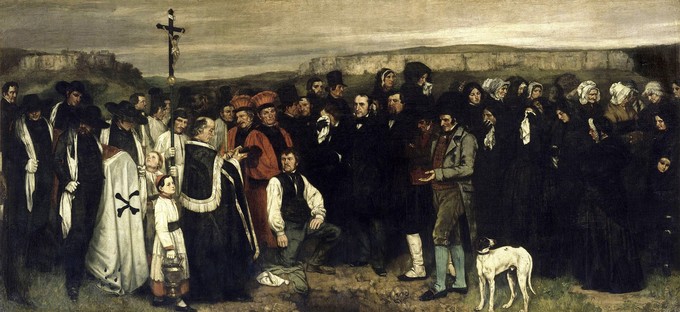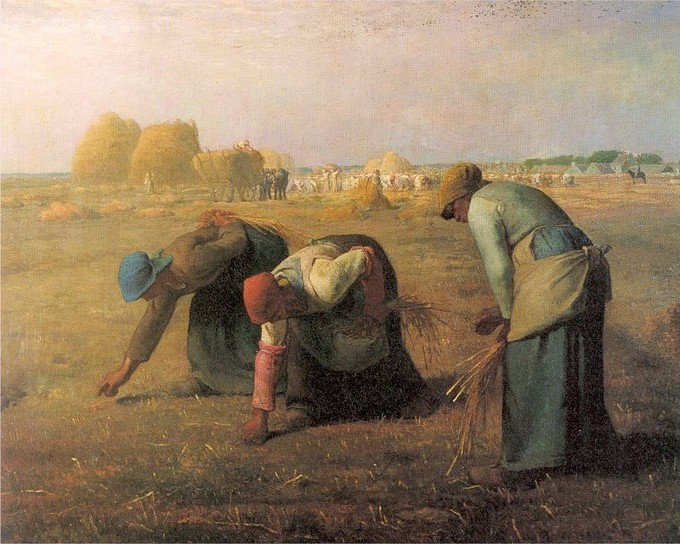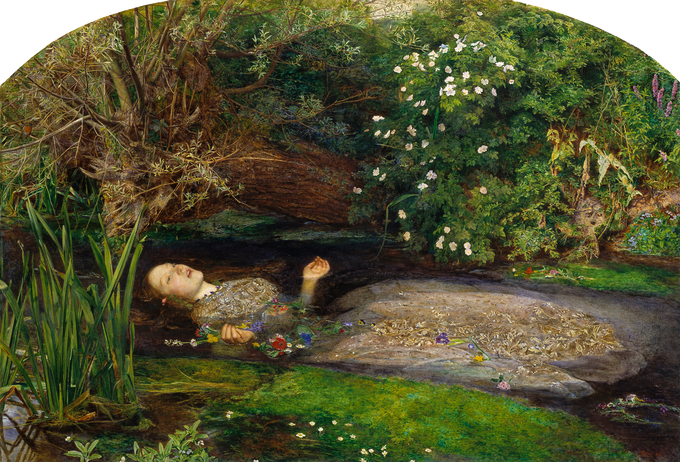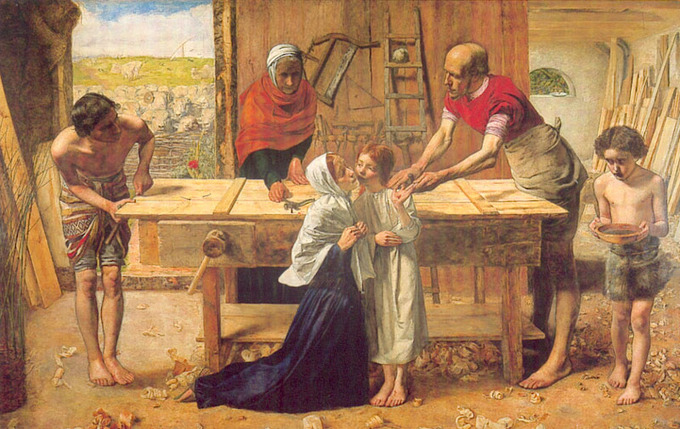31 Realism
Academic Art
For a reading on Art of the Academy see:
https://courses.lumenlearning.com/boundless-arthistory/chapter/academic-art/
Realism
Realism, an artistic movement that began in France in the 1850s, rejected Romanticism, seeking instead to portray contemporary subjects and situations with truth and accuracy.
Key Points
- Realists revolted against the exotic subject matter and exaggerated emotionalism of the Romanticism that had dominated French literature and art since the late 18th century.
- Realist works depicted people of all classes in ordinary life situations, which often reflected the changes brought on by the Industrial and Commercial Revolutions.
- Realists tended to showcase sordid or untidy elements in their paintings.
- Important figures in the Realist art movement were Gustave Courbet, Honore Daumier, and Jean-Francois Millet.
- Realism emerges as socialism emerges in France as an ideas by way of Karl Marx.
Realism was an artistic movement that began in France in the 1850s, following the 1848 Revolution. Realists rejected Romanticism, which had dominated French literature and art since the late 18th century, revolting against the exotic subject matter and exaggerated emotionalism of the movement. Instead, Realists sought to portray “real” contemporary people and situations with truth and accuracy, including all the unpleasant or sordid aspects of life. Realist works depicted people of all classes in ordinary life situations, which often reflected the changes brought on by the Industrial and Commercial Revolutions.
The Realists depicted everyday subjects and situations in contemporary settings, and attempted to depict individuals of all social classes in a similar manner. Classical idealism, Romantic emotionalism, and drama were avoided equally, and often sordid or untidy elements of subjects were showcased somewhat, as opposed to being beautified or omitted. Social realism emphasized the depiction of the working class and treated working class people with the same seriousness as other classes in art. Realism also aimed to avoid artificiality in the treatment of human relations and emotions; treatments of subjects in a heroic or sentimental manner were rejected. Important figures in the Realist art movement were Gustave Courbet, Honore Daumier, and Jean-Francois Millet.
Realism in Painting
Two important figures in the Realist movement were Gustave Courbet and Jean-Francois Millet.
Key Points
- Realism arose in opposition to Romanticism, which had dominated French literature and art since the late 18th century.
- Realist painters often depicted common laborers, and ordinary people in ordinary surroundings engaged in real activities as subjects for their works.
- Gustave Courbet is known as the main proponent of Realism and his paintings challenged convention by depicting unidealized peasants and workers, often on a grand scale traditionally reserved for paintings of religious or historical subjects.
- Gustave Courbet was a socialist and that doctrine informed his work.
- Jean-Francois Millet is noted for his scenes of peasant farmers of which “The Gleaners” is one of his most well-known due to its depiction of the realities of the lower class.
Gustave Courbet
Jean Désiré Gustave Courbet (1819–December 31, 1877) was a French painter who led the Realist movement in 19th century French painting. Rejecting the predominant academic convention and the Romanticism of his time, Courbet’s independence set an example that was important to later artists, such as the Impressionists and the Cubists. As an artist, he occupies an important place in 19th century French painting as an innovator and as an artist willing to make bold social statements in his work.
Courbet’s paintings of the late 1840s and early 1850s brought him his first recognition. They challenged convention by depicting unidealized peasants and workers, often on a grand scale traditionally reserved for paintings of religious or historical subjects. Courbet courted controversy by addressing social issues in his work, and by painting subjects that were considered vulgar, such as the rural bourgeoisie, peasants, and working conditions of the poor. For Courbet realism dealt not with the perfection of line and form, but entailed spontaneous and rough handling of paint, suggesting direct observation by the artist while portraying the irregularities in nature. He depicted the harshness in life, and in so doing challenged contemporary academic ideas of art.
When the Gleaners was exhibited in the Salon of 1857 it was widely criticized for “ugliness” and its seemingly revolutionary subject matter. One critic commented that “his three gleaners have gigantic pretensions, they pose as the Three Fates of Poverty…their ugliness and their grossness unrelieved.” Another said it had the stench of the scaffold about it, referring to the scaffold of the guillotine of 1789.

A Burial at Ornans was a vast painting, measuring 10 by 22 feet (3.1 by 6.6 meters), and drew both praise and fierce denunciations from critics and the public, in part because it upset convention by depicting a prosaic ritual by country people on a scale that previously would have been reserved for a religious or royal subject. Additionally, the painting lacks the sentimental rhetoric that was expected in a genre work. Courbet’s mourners make no theatrical gestures of grief, and their faces seemed more caricatured than ennobled. The critics accused Courbet of a deliberate pursuit of ugliness.
Courbet is quoted as having said, “What was being buried in the Burial at Ornans was Romanticism.”
Jean-Francois Millet
Jean-François Millet (October 4, 1814–January 20, 1875) was a French painter and one of the founders of the Barbizon School in rural France. Millet is noted for his scenes of peasant farmers and can be categorized as part of the Realism art movement.
One of the most well known of Millet’s paintings is The Gleaners (1857). While Millet was walking the fields around Barbizon, one theme returned to his pencil and brush for seven years—gleaning—the centuries-old right of poor women and children to remove the bits of grain left in the fields following the harvest. He found the theme an eternal one, linked to stories from the Old Testament. In 1857, he submitted the painting The Gleaners to the Salon to an unenthusiastic, even hostile, public. The bourgeois audience, in a time when Marx’s manifesto was gaining popularity with the common people, found the potential for revolution in the plight of the underclass unsettling.

Pre-Raphaelites
Key Points
- The Pre-Raphaelites sought to reform art by rejecting what they considered to be a mechanistic approach first adopted by the Mannerist artists who succeeded Raphael and Michelangelo.
- They believed the Classical poses and elegant compositions of Raphael in particular had been a corrupting influence on the academic teaching of art, hence the name “Pre-Raphaelite.” They wanted a return to the abundant detail, intense colors and complex compositions of Quattrocento Italian art.
- Influenced by romanticism, the Pre-Raphaelites thought freedom and responsibility were inseparable. Nevertheless, they were particularly fascinated by medieval culture, believing it to possess a spiritual and creative integrity that had been lost in later eras.
- In later years the movement divided and moved in two separate directions. The realists were led by Hunt and Millais, while the medievalists were led by Rossetti and his followers, Edward Burne-Jones and William Morris.
Key Terms
- Mannerist: An artist who uses Mannerism, a style of European art that emerged from the later years of the Italian High Renaissance around 1520.
- quattrocento: The 1400s, the 15th century Renaissance Italian period.
The Pre-Raphaelite Brotherhood
The Pre-Raphaelite Brotherhood (also known as the Pre-Raphaelites) was a group of English painters, poets, and critics, founded in 1848 by William Holman Hunt, John Everett Millais, and Dante Gabriel Rossetti. The three founders were soon joined by William Michael Rossetti, James Collinson, Frederic George Stephens and Thomas Woolner to form a seven-member brotherhood. The group’s intention was to reform art by rejecting an approach that they considered mechanistic, one that was first adopted by the Mannerist artists who succeeded Raphael and Michelangelo. Its members believed the Classical poses and elegant compositions of Raphael in particular had been a corrupting influence on the academic teaching of art, hence the name “Pre-Raphaelite.” The Pre-Raphaelites wanted a return to the abundant detail, intense colors and complex compositions of Quattrocento Italian and Flemish art. The Pre-Raphaelites defined themselves as a reform movement, created a distinct name for their form of art, and published a periodical, The Germ, to promote their ideas.
The brotherhood’s early doctrines emphasized the personal responsibility of individual artists to determine their own ideas and methods of depiction. Influenced by Romanticism, the Pre-Raphaelites thought freedom and responsibility were inseparable. Nevertheless, they were particularly fascinated by medieval culture, believing it to possess a spiritual and creative integrity that had been lost in later eras.
Pre-Raphaelites and Realism
The emphasis on medieval culture clashed with principles of realism, which stressed the independent observation of nature. In its early stages, the Pre-Raphaelite Brotherhood believed its two interests were consistent with one another, but in later years the movement divided and moved in two separate directions. The realists were led by Hunt and Millais, while the medievalists were led by Rossetti and his followers, Edward Burne-Jones and William Morris. The split was never absolute, since both factions believed that art was essentially spiritual in character, opposing their idealism to the materialist realism associated with Courbet and impressionism.
The Pre-Raphaelite Brotherhood was greatly influenced by nature and its members used great detail to show the natural world using bright and sharp focus techniques on a white canvas. In attempts to revive the brilliance of color found in Quattrocento art, Hunt and Millais developed a technique of painting in thin glazes of pigment over a wet white ground in the hope that the colors would retain jewel-like transparency and clarity. Their emphasis on brilliance of color was a reaction to the excessive use of bitumen by earlier British artists. Bitumen produces unstable areas of muddy darkness, an effect the Pre-Raphaelites despised.

Exhibitions
The first exhibitions of Pre-Raphaelite work occurred in 1849. Both Millais’s Isabella (1848–1849) and Holman Hunt’s Rienzi (1848–1849) were exhibited at the Royal Academy. Rossetti’s Girlhood of Mary Virgin was shown at a Free Exhibition on Hyde Park Corner. As agreed, all members of the brotherhood signed their work with their name and the initials “PRB.”
In 1850 the Pre-Raphaelite Brotherhood became the subject of controversy after the exhibition of Millais’s painting, Christ in the House of His Parents, which was considered to be blasphemous by many reviewers, notably Charles Dickens. The brotherhood’s medievalism was attacked as backward-looking and its extreme devotion to detail was condemned as ugly and jarring to the eye. According to Dickens, Millais made the Holy Family look like alcoholics and slum-dwellers, adopting contorted and absurd “medieval” poses.

After 1856, Dante Gabriel Rossetti became an inspiration for the medievalizing strand of the movement. He was the link between the two types of Pre-Raphaelite painting (nature and romance) after the PRB became lost in the late 1800s. Rossetti, although the least committed to the brotherhood, continued the name and changed its style. He began painting versions of women using models like Jane Morris, in paintings such as Proserpine, after the Pre-Raphaelites had disbanded.
Since the Pre-Raphaelites were fixed on portraying subjects with near-photographic precision—though with a distinctive attention to detailed surface-patterns—their work was devalued by many painters and critics. For instance, after the First World War, British Modernists associated Pre-Raphaelite art with the repressive and backward times in which they grew up.

